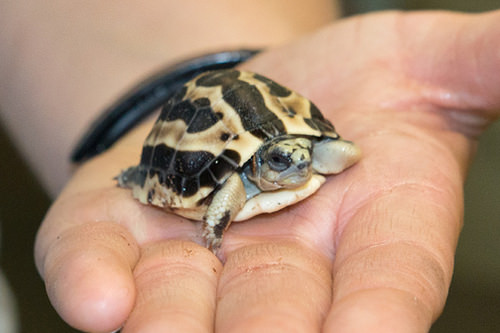Critically Endangered Spider Tortoise Hatches at the Smithsonian's National Zoo
Tomorrow is World Turtle day. The Smithsonian's National Zoo is celebrating a conservation milestone; for the first time, a rare spider tortoise has hatched in the Reptile Discovery Center. Animal care staff are closely monitoring the hatchling, which emerged May 10 in an off-exhibit area. Staff have not yet verified the two-week-old tortoise's sex, as when they are young they show no sexual dimorphism. Keepers report that it appears to be thriving and are encouraged by its growth. If the tortoise continues to progress, it will be on exhibit this summer. In the meantime, Zoo visitors can see a family group of adult male spider tortoises on exhibit.
The tortoise's parents came to the Zoo in January 2014 per a breeding recommendation from the Association of Zoos and Aquariums' (AZA) Species Survival Plan. Female spider tortoises do not lay a clutch of eggs; rather, they lay one egg at a time over a period of months. The Zoo's female laid her first egg in August 2014, but that egg did not hatch. The second egg was laid in September 2014, and this hatchling emerged. A third egg, laid in October 2014, has yet to hatch. Spider tortoise eggs can be difficult to hatch in human care, in part because they must be incubated, cooled, and incubated again during the embryo's development. The Zoo will share the information gathered about this species'breeding and development with AZA for the benefit of other institutions that exhibit and want to breed this species.
Spider tortoises are listed as critically endangered on the International Union for Conservation of Nature's Red List of Threatened Species. Native to the forests and sandy coastlines of Madagascar, their populations have declined by 80 percent since 1970 and populations continue to dwindle due to habitat loss and wildlife trafficking for the food and pet trade.

